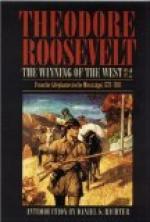The history of Kentucky and the Northwest has now been traced from the date of the Cherokee war to the close of the Revolution. Those portions of the southwestern lands that were afterwards made into the State of Tennessee, had meanwhile developed with almost equal rapidity. Both Kentucky and Tennessee grew into existence and power at the same time, and were originally settled and built up by precisely the same class of American backwoodsmen. But there were one or two points of difference in their methods of growth. Kentucky sprang up afar off in the wilderness, and as a separate entity from the beginning. The present State has grown steadily from a single centre, which was the part first settled; and the popular name of the commonwealth has always been Kentucky. Tennessee, on the other hand, did not assume her present name until a quarter of a century after the first exploration and settlement had begun; and the State grew from two entirely distinct centres. The first settlements, known as the Watauga, or afterwards more generally as the Holston, settlements, grew up while keeping close touch with the Virginians, who lived round the Tennessee head-waters, and also in direct communication with North Carolina, to which State they belonged. It was not until 1779 that a portion of these Holston people moved to the bend of the Cumberland River and started a new community, exactly as Kentucky had been started before. At first this new community, known as the Cumberland settlement, was connected by only the loosest tie with the Holston settlements. The people of the two places were not grouped together; they did not even have a common name. The three clusters of Holston, Cumberland, and Kentucky settlements developed independently of one another, and though their founders were in each case of the same kind, they were at first only knit one to another by a lax bond of comradeship.
In 1776 the Watauga pioneers probably numbered some six hundred souls in all. Having at last found out the State in which they lived, they petitioned North Carolina to be annexed thereto as a district or county. The older settlements had evidently been jealous of them, for they found it necessary to deny that they were, as had been asserted, “a lawless mob”; it may be remarked that the Transylvanian colonists had been obliged to come out with a similar statement. In their petition they christened their country “Washington District,” in honor of the great chief whose name already stood first in the hearts of all Americans. The document was written by Sevier. It set forth the history of the settlers, their land purchases from the Indians, their successful effort at self-government, their military organization, with Robertson as captain, and finally their devotion to the Revolutionary cause; and recited their lack of proper authority to deal promptly with felons, murderers, and the like, who came in from the neighboring States, as the reason why they wished to become a self-governing portion




